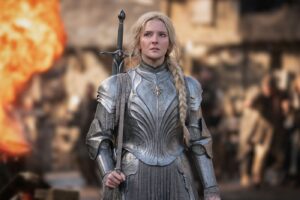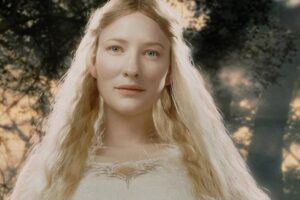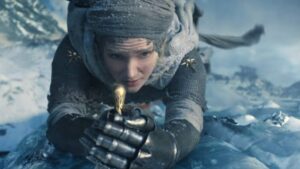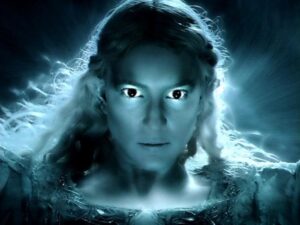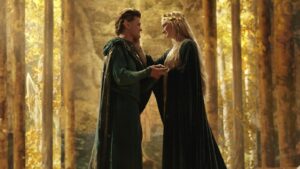POTENTIAL SPOILERS FOR THE RINGS OF POWER AHEAD!
Empire Magazine’s July issue is currently hitting newsstands all across the country, and those lucky enough to have grabbed a copy already will no doubt be enjoying reading through exclusive interviews with the cast and crew of Amazon’s The Rings Of Power, accompanied by beautiful images from the set – all of which I’ve already seen, mind you, because someone leaked grainy photos of the photos in the magazine a couple days ago, but now that the high-resolution versions of these images are available to us all I figured I ought to share my thoughts and rank the images in order of how much I like them.
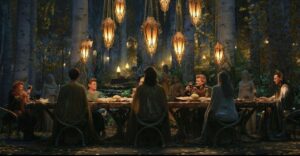
I won’t be talking about the interviews in this post, because to be quite honest there’s not a lot of new information contained in the interviews. With the exception of showrunners J.D. Payne and Patrick McKay boldly declaring that they have all five seasons of The Rings Of Power mapped out (right down to the final shot of the final episode), most of it is stuff we’ve heard before. There are also one or two images that I’ve left out of my ranking, because they’re behind-the-scenes shots of actors surrounded by cameras and not very indicative of how the scenes will look with finished special effects and proper lighting and everything. With those disclaimers out of the way, let’s get into it!
My favorite of the new images is the one I’ve chosen to position at the top of the post, so that it will be the thumbnail on Twitter and other social media platforms. This is probably a scene from an early episode of season one in which Galadriel (second-from right, with her back to us) is invited to the banquet-table of King Gil-galad of Lindon (seated at the far right), giving her a chance to catch up with old friends like Elrond half-Elven (third-from-left) and Celebrimbor (third-from-right), and make new friends like Durin IV of Khazad-dûm (at the far left). There’s a character seated directly between Elrond and Celebrimbor with their face obscured, which has led to speculation that this is Tar-Míriel of Númenor.
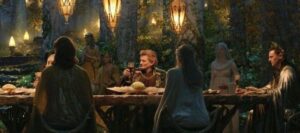
Celebrimbor appears to be leading the attendees in a toast – perhaps in response to Durin IV announcing his betrothal to Princess Disa, or Galadriel reporting on her fight with a snow-troll in the Forodwaith? Note that Gil-galad hasn’t raised his glass, and in fact wears a distinctly dour expression on his face. Maybe Celebrimbor is trying to hog the spotlight? For The Rings Of Power to characterize him as an attention-seeking peacock might seem blasphemous on the surface, but if you think about it, it’s only natural that the last and currently the least-accomplished of the Fëanorians would want all eyes on him. I mean, he falls for Sauron’s flattery, doesn’t he?
The composition of the image is absolutely exquisite – if I didn’t know this was a still from The Rings Of Power, and you told me it was a long-lost pre-Raphaelite painting, I’d believe you. The same can also be said of our next image, which depicts Gil-galad presenting Galadriel with a crown of golden laurel-leaves during some kind of coronation ceremony in Lindon. Canonically, however, Galadriel was already living in Lindon by the time Gil-galad settled there and established his kingdom on her land, and she’s significantly older than him at any rate, so until we know the context of this scene it’s just…amusing, that’s all.
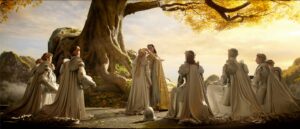
But anyway, if it weren’t for the fanciful Medieval armor worn by Galadriel and the extras surrounding her, and the close-cropped hair on most of the male Elves, this image would probably be my favorite. You know how there are certain photos that just deserve to be made into thousand-piece jigsaw puzzles that you can display on your coffee table to impress house-guests? This is one of them, and I would buy that, Amazon, so…take notes.
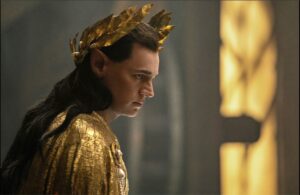
If you couldn’t tell, I quite like the look of Benjamin Walker as Gil-galad, High King of the Noldor in Middle-earth. He’s one of the only male Elves in The Rings Of Power with the classic flowing locks that I, at least, still associate with Elves because (a) Peter Jackson’s movies have left me with a clear mental image of how an Elf “should” look, and getting my brain to accept short-haired Elves is gonna take some work, (b) Tolkien described male Elves as having long hair on multiple occasions, and even went so far as to say that High Elves find long hair to be particularly beautiful, so it has a basis in canon, and (c) long hair looks good on guys, obviously.

Another great candidate for a puzzle, but this would be that puzzle that stays unfinished for days because once you got the tower and the panoramic landscape out of the way you’re left with hundreds of identical cloud-colored pieces that nobody wants to take (yes, I will drive the jigsaw-puzzle metaphor into the ground before we’re through with this). In this picture, a character believed to be Ismael Cruz Córdova as the Silvan Elf Arondir stands atop a watchtower and looks out over a mountain valley dotted with farms, croplands, roads, rivers, and little forests.
Tolkien fans are divided over where in Middle-earth this is, with the prevailing theory being that the watch-tower is situated in the southern crook of the Ephel Dúath or Mountains of Mordor, far south of what will one day become the barren Plateau of Gorgoroth. According to this theory, Arondir is looking out eastward across a Mordor not yet ruled by Sauron, one that is still green and fertile and inhabited by both humans and Elves. In the distance, there’s a glimmer of light on a lake that could very well be the inland Sea of Núrnen.

Alternatively, that glimmer of light is the ocean, and this watchtower is just outside of Mordor’s margins in north Harad with the jagged peaks of the Ephel Dúath on the right – which would mean that Arondir is looking west, not east. So confusing. Either way, we know that this is somewhere in the south of Middle-earth because Arondir and his human lover Bronwyn live in a village with the Sindarin name Tirharad, which roughly translates to “south-watch” or “watch over the south”, a name that I now think refers specifically to this tower looming over the village and the surrounding countryside. But who built it, and why?
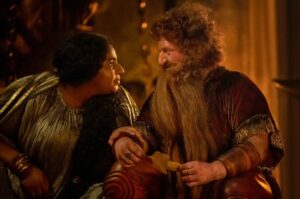
Despite the Dwarves of Khazad-dûm being the subjects of one of the three Empire Magazine covers released for this issue, there are surprisingly few images of Dwarves in the actual magazine – just one, in fact, but it’s a beautiful close-up on Prince Durin IV and Princess Disa sitting together and staring lovingly into each other’s eyes. Durin holds a distinctive golden leaf, which says to me that the couple are in Lindon – obviously trees with golden leaves could grow elsewhere in Middle-earth, but since we already know Durin will be in Lindon for Gil-galad’s banquet, it’s reasonable to assume Disa joins him. Maybe this is their honeymoon?
Then again, Tolkien wrote of Dwarven women in the Appendices to The Lord Of The Rings that “they seldom walk abroad except at great need” (not that The Rings Of Power should be beholden to that one line, by any means), so perhaps this scene takes place after Durin returns to Khazad-dûm with a small souvenir from Lindon for his wife or wife-to-be. They really seem like a sweet couple, and I’m interested to see what role they have to play in the story of the forging of the Rings of Power, given that it wasn’t Durin IV but Durin III (his father, in the show) who received one of the seven Rings given to the Dwarves by Celebrimbor and Sauron. That means there are plenty of options for where to take this story.
(With that said, I am once again begging The Rings Of Power costume designers to let us see Disa and Durin IV in new outfits. I love these fits, I really do, but this is Dwarven royalty we’re talking about here, and it’s not like Khazad-dûm’s princes and princesses don’t have money or resources to spend on extravagant clothes. I want to see opulence!)
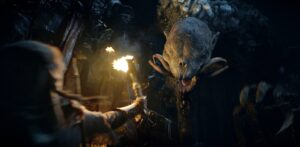
Okay, so Amazon’s cheating a little bit with this one. We’ve already seen this image in the teaser trailer, it’s just been cleaned up a bit. But it’s nearer the top of my list because it’s improved my opinions on the teaser trailer. I didn’t love that whole scene with the snow-troll in the cave when I first saw it, but now I’m actually excited to see more of this grotesque creature with its wicked tusks and its long tangled beard filled with chunks of ice and stone. I feel for that poor Elf played by Kip Chapman who’s probably not going to make it out of the first episode alive, just based on the size of that troll’s claws and the speed with which it moved in the trailer.
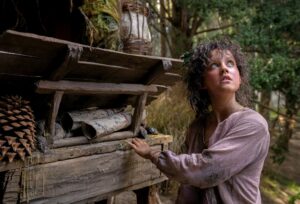
You cannot tell me that Markella Kavenagh is not well-cast as a hobbit after seeing this image – I’m sorry, you just can’t. We know next to nothing about her character, Elanor “Nori” Brandyfoot, but I would not be surprised if she turns out to be the distant ancestor of one Frodo Baggins, based solely on the striking resemblance between Kavenagh and Lord Of The Rings-era Elijah Wood that becomes almost uncanny when you put Kavenagh in a curly wig, as the Rings Of Power costume designers have done. They already have the same big blue eyes and delicate facial features, now all that Kavenagh’s character is missing is her very own Ring of Power – but who knows, she might get one of those too by the end of this show.

I’m lumping together all of my favorite Harfoot pictures because they’re all sort of similar, and I like them roughly the same amount. I actually adore this picture in particular because it’s just so sweet – we have Dylan Smith as Largo, Markella Kavenagh as Elanor, and Megan Richards as Poppy Proudfellow, and they have all leaves or herbs in their hair and they’re smiling and holding hands, and it’s like something straight out of one of those cheerful 17th Century Dutch paintings portraying the idyllic country life. I don’t know what the Harfoots have to be smiling about, but I’m sorry that they probably won’t be smiling for long, as there’s a rumor floating around that several Harfoots will die before the end of season one.
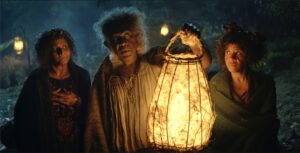
More Harfoots, and a better look at Sir Lenny Henry as Sadoc Burrows, their leader. In this scene, which presumably follows hard on the heels of Meteor Man crashing to earth and being discovered in the woods by Elanor Brandyfoot, Sadoc takes the initiative and ventures out into the night armed with only a lantern to investigate. Maybe they’ll find evidence of Meteor Man’s crash landing, but Elanor will find the man himself and hide him from her disapproving village elders, or perhaps Sadoc goes to the crash-site after Elanor brings the stranger into their camp to find out where he really came from and what he’s up to – there’s so many possibilities, and absolutely none of this has any basis in canon which unfortunately makes it really difficult to theorize.
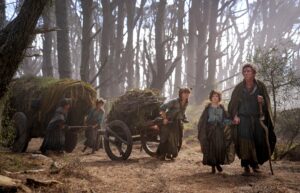
Even more Harfoots, and now they’re on the move. I don’t love this image, mostly because it looks very much like a soundstage with fake trees and a forest path that’s slightly too flat and well-tended to be believable. But the Harfoots themselves are impossible to dislike, and I must say, I do think it’s adorable that they all wear odd little bits and bobbins in their hair like small fairy-wings or tiny antlers. It’s Willow by way of Cecily Mary Barker, which is weird when you remember that this is still supposed to be Rings Of Power and not any of those things, but hey, it’s something new at least, so let’s give it a chance. If it works, it works; if it doesn’t, they still have time to change course before season two starts filming.
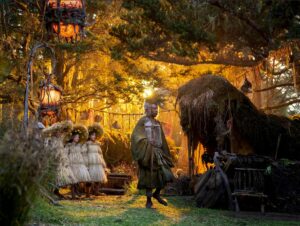
There’s so much going on in this photo, it’s hard to know what to take away from it, exactly. You’ve got Lenny Henry in the foreground, dancing and wearing a bushel of wheat as a crown….and then you’ve got the Harfoot children’s choir off in the lower left-hand corner but they’re wearing oversized bonnets made of wheat, and I think they’re supposed to resemble corn dollies (it’s a European thing, look it up)…and then up in the top-left corner you’ve got these unspeakably ugly fairy garden lanterns that look like they were bought off Etsy…and the whole scene is illuminated by this unrealistically golden light that makes it look like the cover of Better Hobbit-holes & Gardens.
In this smorgasbord of aesthetics, I’m not seeing any Neolithic or Bronze Age design influences. Now, you could argue that it’s my own fault for expecting those influences to be present when Amazon never actually promised that the Harfoots would be portrayed as a Bronze Age culture, and that was always kinda just me extrapolating on the hints in the character posters and the fact that The Rings Of Power is set over three-thousand years before The Lord Of The Rings so it made sense (and still makes sense) to me that the Harfoots of the mid to late Second Age would be as different from Hobbits of the late Third Age as the Beaker people of 2500 BC were from British people of the late 19th Century…and you’d be right, but I still feel cheated that what I got instead were ghastly fairy garden lanterns.
I’d have put this image much higher in my rankings were it not for those lanterns, because I’m totally onboard with the idea of prehistoric Hobbits worshipping fertility deities like Yavanna in the hopes of more bountiful harvests. That tracks. But now, not only will I be worried for the next few months that the Harfoots don’t belong in The Rings Of Power to begin with (because as much as I’ve tried to suppress that fear and tell myself it’ll all work out in the end, the ominous feeling of dread hasn’t ever fully gone away), now I’ll also be worried about those lanterns popping up and ruining the vibe of otherwise perfect scenes.
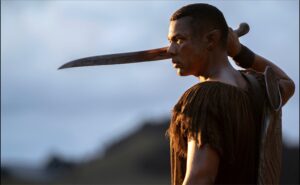
Ismael Cruz Córdova is hot enough that him being the only thing in this image isn’t really the problem – rather, the problem is that the photographer has only given me a sliver of Cruz Córdova to admire, and I can’t even see the intricate detail-work on his character’s unique wooden armor, because he has his back partially turned, so I’m left without anything to focus on…except, of course, Ismael Cruz Córdova’s chiseled features and remarkably beautiful eyes, which in this light appear gold. This man’s mere existence is almost enough to convince me that male Elves with short hair aren’t such a bad idea after all.
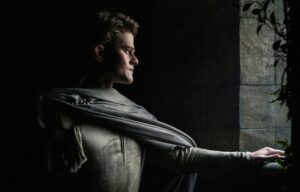
I’m sorry to have to put Elrond so far down on the list, but this close-up tells me nothing about his character. He’s standing at a window, looking out, and…that’s about it. The most interesting thing about this image isn’t even Elrond, it’s the lighting, which is actually quite atmospheric. But it’s not enough to outweigh the blandness of the outfit, the stiff pose, and the fact that the hairstylist on this show clearly had a personal vendetta against poor Robert Aramayo.
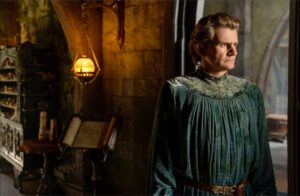
Twitter was not very kind to Charles Edwards when they found out he was playing Celebrimbor, and while I admit that Edwards isn’t anything like the Celebrimbor I envisioned when reading Unfinished Tales, I think there are significantly more nuanced discussions to be had regarding this casting than just “he looks different than how I imagined, therefore he will be a terrible Celebrimbor”. For instance, we could be questioning the logic behind casting a fifty-two year old actor to play Celebrimbor, whose older cousin Galadriel is played by an actress in her early thirties. What’s up with that, anyway?
And even if we try to look past that, the image itself offers nothing of great interest to look at instead. For whatever reason, Celebrimbor is depicted standing in the middle of a sparsely-decorated hallway, wearing a shapeless green garment and a sullen expression. There’s no ornament on his person nor any detail in the set dressing behind him to suggest that the subject of this image is the greatest blacksmith, craftsman, and jeweler of his generation, or that he will soon put an army of like-minded artists to work forging the Rings of Power in Eregion. If he has any Rings on his fingers, even lesser ones, we can’t see them.
Keep in mind that, despite Celebrimbor’s prominent role in the non-canonical but supposedly very entertaining Shadow Of Mordor video games, he’s only mentioned three times in the text of The Lord Of The Rings and not once in Peter Jackson’s films, so most of the people looking at this image won’t recognize his name or remember his role in the story. They’ll just see a regular-looking guy, and that’s what worries me. Forget trying to appease Celebrimbor’s diehard fans, this image really needed to give casual fans something familiar to grab hold of; something that would tell them who this guy is, and why they should care about him. And it doesn’t.
Imagine if we had seen Celebrimbor standing at his anvil in the heat of the forge, surrounded by the jewel-smiths of the Gwaith-i-Mírdain, contemplating his next move and perhaps running his hands over a ring mold (I don’t know the first thing about blacksmithing, so forgive me if that’s not the correct term) – or anything, really, that would give casual fans a hint as to Celebrimbor’s importance while reassuring diehard fans that this is still Celebrimbor, despite the new look. There was potential here, but sadly, it was squandered.
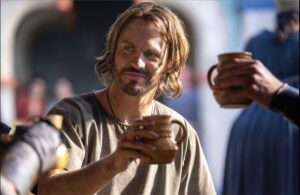
I have my suspicions regarding Halbrand, the character depicted in this photo drinking with friends or comrades. We don’t know where he comes from, we don’t know how he and Galadriel end up on a raft in the middle of the ocean, drifting towards Númenor, and we don’t know what happens to him after they arrive on the island (mind you, there have been several detailed leaks concerning Galadriel’s interactions with Tar-Míriel, Ar-Pharazôn, Elendil, and pretty much everyone on Númenor). Halbrand is an enigma, and I believe Amazon wants to keep it that way for at least as long as season one is airing. He’s the original character most widely speculated to be either Sauron in disguise or one of the future Nazgûl.
The image itself, however, is boring. Halbrand is plainly dressed, the background seems deliberately blurred so as to hide what is presumably Númenórean architecture, and the characters sitting around Halbrand are just a bunch of disembodied arms and hands. I feel like this is probably a scene involving some important characters being hidden from us, including Ar-Pharazôn (I have no evidence for that claim, just a gut instinct).
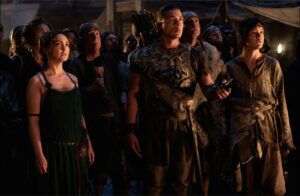
My least favorite image of the lot has to be this one. It’s so overwhelmingly cluttered you’d think that someone or something here would catch my eye, but the composition and lighting ensure that even the main characters are almost indistinguishable from the extras in the background. Bronwyn and her son Theo stand on either side of the Silvan Elf Arondir, placing this scene somewhere in or around the village of Tirharad. It’s hard to make out, but Arondir is holding the hilt-shard of the broken sword featured on Theo’s character poster – he appears to be offering it to someone we can’t see.
Well, what do you know, that’s the last of ’em. At this point, I don’t think anything is likely to keep me from watching The Rings Of Power, but I’ll be honest, I was surprised by how many of these new photos left me a little underwhelmed – and I can’t tell if that’s just Amazon’s marketing team choosing weird stills from the first few episodes to highlight because they’re trying not to spoil later episodes, or if they genuinely have no idea how to sell this show. A lot of these pictures are just close-up images of characters we don’t know yet that tell us little to nothing about who they are or why we ought to care, and if Amazon is worried about saying too much in their marketing campaign they should just focus on blowing fans’ minds with incredible visuals, beautiful scenery, and the kind of big-budget VFX you can’t get from most TV shows.
But now that you’ve seen all the images, I want to hear what you think; which ones got you excited for The Rings Of Power, which ones disappointed you, and which you think are promising or maybe need some time to mull over. Share your own thoughts, theories, and opinions, in the comments below!








